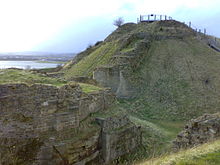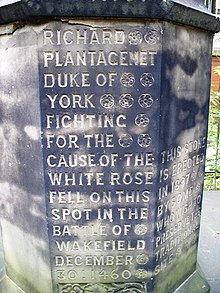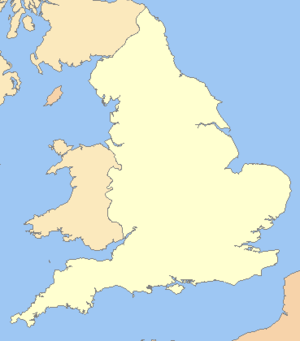Battle of Wakefield
| Battle of Wakefield | |||||||
|---|---|---|---|---|---|---|---|
| Part of the Wars of the Roses | |||||||
 | |||||||
| |||||||
| Belligerents | |||||||
|
|
| ||||||
| Commanders and leaders | |||||||
|
Andrew Trollope |
| ||||||
| Strength | |||||||
| possibly up to 18,000 | "a few hundred" to 9,000 | ||||||
| Casualties and losses | |||||||
| perhaps 200 | 700 – 2,500 | ||||||
The Battle of Wakefield took place in Sandal Magna near Wakefield, in West Yorkshire in Northern England, on 30 December 1460. It was a major battle of the Wars of the Roses. The opposing forces were an army led by nobles loyal to the captive King Henry VI of the House of Lancaster, his Queen Margaret of Anjou and their seven-year-old son Edward, Prince of Wales on one side, and the army of Richard, Duke of York, the rival claimant to the throne, on the other. The Duke of York was killed and his army was destroyed.
Background
King Henry VI ascended the throne when he was only nine months old. He grew up to be an ineffective king, and prone to spells of mental illness. There were increasingly bitter divisions among the regents and councillors who governed in Henry's name, mainly over the conduct of the Hundred Years' War with France. By the late 1440s, two opposing factions had formed behind Edmund Beaufort, 2nd Duke of Somerset, and Richard of York. York was Lieutenant in France for several years and resented being supplanted in that office by Somerset, who had then failed to defend Normandy against French armies.[1]
Richard of York was not only the wealthiest magnate in the land,[2] but was also descended through both his parents from King Edward III, leading to calls that he be recognised as successor to the childless King Henry.[3] His rival, Somerset, belonged to the Beaufort family, who were distant cousins of King Henry. Originally illegitimate, the Beauforts had been made legitimate by an Act of Parliament but Henry VI's grandfather had barred them from the line of succession to the throne (to protect his own children's succession).[4] However, there was always the possibility that this could be circumvented and the Beaufort line eventually produced King Henry VII and the Tudor dynasty.
In 1452, York attempted to force Henry to dismiss Somerset from the government, but at this stage he lacked support and was forced to swear not to take arms against the King at Old St Paul's Cathedral.[5] Then in 1453, Henry VI suffered a complete mental breakdown. The peers appointed York Lord Protector and he governed the country responsibly, but Henry recovered his sanity after eighteen months and restored Somerset to favour. During Henry's madness his Queen, Margaret of Anjou, had given birth to a son, which dashed York's hopes of becoming king on Henry's death.
Fearing arrest for treason, York and his most prominent allies, the Nevilles (York's brother in law, the Earl of Salisbury and his son, the Earl of Warwick, later known as the "Kingmaker"), finally resorted to armed force in 1455. At the First Battle of St Albans, many of York's and Salisbury's rivals and enemies were killed, including Somerset, the Earl of Northumberland (whose family had been involved in a long-running feud with the Nevilles) and Lord Clifford.
After the battle, York reaffirmed his loyalty to King Henry, and was reappointed Lord Protector and Lieutenant of Ireland. Margaret of Anjou nevertheless suspected York of wishing to supplant her infant son, Edward, as Henry's successor, and the heirs of the Lancastrian nobles who were killed at St Albans remained at deadly feud with York.
Events of the year preceding Wakefield
After an uneasy peace during which attempts at reconciliation failed, hostilities broke out again in 1459. Richard of York once again feared indictment for rebellion by a Great Council dominated by his opponents.[6] He and the Nevilles concentrated their forces near York's stronghold at Ludlow Castle in the Welsh Marches but at the confrontation with the royal army which became known as the Battle of Ludford, some of Warwick's contingent from the garrison of Calais, led by experienced captain Andrew Trollope, defected overnight. York and the Nevilles promptly abandoned their troops and fled. The next day, the outnumbered and leaderless Yorkist army surrendered.
York went to Ireland, while Salisbury, Warwick and York's eldest son Edward, Earl of March made their way to Calais, where Warwick was Constable. Lancastrian attempts to reassert their authority over Ireland and Calais failed, but York and his supporters were declared traitors and attainted. The victorious Lancastrians became reviled for the manner in which their army had looted the town of Ludlow after the Yorkist surrender at Ludford Bridge, and the repressive acts of a compliant Parliament of Devils which caused many uncommitted peers to fear for their own property and titles.[7] The country remained in disorder.
In 1460, the Nevilles invaded England through a foothold they had already established at Sandwich and rapidly secured London and the South of England where Warwick had popular support. They then advanced north to engage Henry's army in the Midlands. At the Battle of Northampton, part of the Lancastrian army defected and the rest were decisively defeated.[8] Henry was captured on the battlefield for the second time. He was taken to London, and confined in the Bishop of London's palace.[9] George Neville, Bishop of Exeter, was appointed Chancellor of England and Viscount Bourchier (York's brother in law) was appointed Treasurer.[10]
The Duke of York landed in Chester some weeks later and made his way to London with much pomp. Entering Parliament, he attempted to claim the throne, but was met with stunned silence. Even his close allies were not prepared to support such a drastic step.[11] Instead, after the House of Lords had considered his claim, they passed the Act of Accord, by which Henry would remain king, but York would govern the country as Lord Protector. Henry's son was disinherited, and York or his heirs would become king on Henry's death.[12] The powerless and frightened Henry was forced to assent.
Lancastrian moves
When the Battle of Northampton was fought, Queen Margaret and her seven-year-old son Edward had been at Eccleshall Castle near Coventry. After many adventures with brigands and outlaws[13] they fled via Cheshire to Harlech Castle in North Wales, where they joined Lancastrian nobles (including Henry's half-brother Jasper Tudor and the Duke of Exeter) who were recruiting armies in Wales and the West Country. They later proceeded by ship to Scotland, where Margaret gained troops and other aid for the Lancastrian cause from the Queen and Regent, Mary of Guelders, in return for the surrender of the town and castle of Berwick upon Tweed.[14]
At the same time, other Lancastrians were rallying in Northern England. Many of them, including the Earl of Northumberland and Lords Clifford and Ros, had estates and influence in the north. They were later joined by the Duke of Somerset and the Earl of Devon, who brought their forces from the West Country.[13] Northumberland, Clifford and Somerset were the sons of York's and Salisbury's rivals who had been killed at St. Albans.
The attitude of another influential noble in the north was also to be important, according to several accounts. The hot-headed John Neville of Raby had been a leading protagonist in the feud between the Nevilles and the Percies (the family of the Earls of Northumberland) in the 1450s.[15][16] However, he also was a member of the senior branch of the Neville family which had been largely disinherited and eclipsed by the cadet branch headed by the Earl of Salisbury[17] and had much to gain by York's and Salisbury's destruction.[18]
The Lancastrian forces mustered near Kingston upon Hull, and were said (in Gregory's Chronicle, a near-contemporary account) to number 15,000. A substantial part of these forces encamped at Pontefract began pillaging York's and Salisbury's estates nearby.
York's response
Faced with these challenges to his authority as Protector, York despatched his eldest son Edward to the Welsh Marches to contain the Lancastrians in Wales and left the Earl of Warwick in charge in London. He himself marched to the north of England on 9 December, accompanied by his second son Edmund, Earl of Rutland, and the Earl of Salisbury. His force was said by some to number 8,000 to 9,000 men, but by others to be only a few hundred strong, as York intended to recruit local forces with a Commission of Array.[19]
York had probably underestimated the numbers of the Lancastrian army in the north, which was still being reinforced. On 16 December, at the Battle of Worksop in Nottinghamshire, York's vanguard clashed with a contingent from the West Country moving north to join the Lancastrian army, and was defeated.[20]
Battle

On 21 December, York reached his own fortress of Sandal Castle near Wakefield. He sent probes towards the Lancastrian camp at Pontefract 9 miles (14 km) to the east, but these were repulsed. York sent for help to his son Edward, but before any reinforcements could arrive, he sortied from the castle on 30 December.
It is not known for certain why York did so. One theory was later recounted in Edward Hall's chronicle, written a few decades after the event, but partly from first-hand sources, and the contemporary Burgundian Jean de Waurin's chronicle. In a stratagem possibly devised by the veteran Andrew Trollope, half the Lancastrian army under Somerset and Clifford advanced openly towards Sandal Castle, over the open space known as "Wakefield Green" between the castle and the River Calder, while the remainder under Ros and the Earl of Wiltshire were concealed in the woods surrounding the area.[21] York was probably short of provisions in the castle and seeing that the enemy were apparently no stronger than his own army, seized the opportunity to engage them in the open rather than withstand a siege while waiting for reinforcements.[22]
Other accounts suggested that, possibly in addition to Trollope's deception, York was fooled by some of John Neville of Raby's forces displaying false colours into thinking that reinforcements sent by Warwick had arrived. By another account, the Annales Rerum Anglicorum, John Neville himself obtained a Commission of Array from Richard of York to raise 8,000 men to fight on York's side under his older brother, the Earl of Westmoreland, who apparently was a simpleton by this time but nevertheless the most senior peer in the family.[18] Having gathered this force and enticed York to leave the castle to rendezvous with him, John Neville then defected to the Lancastrians.[21] Trollope was also supposed to have sent messages via feigned deserters that he was prepared to change sides once again to support York.[23]
Another suggestion was that York and his opponents had agreed a day for battle (6 January, the Feast of Epiphany) after a Christmas truce, but when York moved into the open the Lancastrians treacherously attacked earlier than had been agreed, catching York at a disadvantage while many of his men were absent foraging for supplies.[24] The simplest suggestion was that York acted rashly.[13] For example, historian John Sadler states that there was no Lancastrian deception or ambush; York led his men from the castle on a foraging expedition, and as successive Lancastrian contingents joined the battle, York's army was outnumbered and overwhelmed.[25]
The Yorkists marched out of Sandal Castle down the present-day Manygates Lane towards the Lancastrians located to the north of the castle. It is generally accepted that, as York engaged the Lancastrians to his front, others attacked him from the flank and rear, cutting him off from the castle. In Edward Hall's words:
... but when he was in the plain ground between his castle and the town of Wakefield, he was environed on every side, like a fish in a net, or a deer in a buckstall; so that he manfully fighting was within half an hour slain and dead, and his whole army discomfited.[26]
The Yorkist army was surrounded and destroyed.
Casualties
One near-contemporary source (Gregory's Chronicle) claimed that 2,500 Yorkists and 200 Lancastrians were killed, but other sources give wildly differing figures, from 2,200 to only 700 Yorkist dead.
The Duke of York was killed in the fighting. His son Rutland attempted to escape over Wakefield Bridge, but was overtaken and killed, possibly by Clifford in revenge for his father's death at St Albans. Salisbury's fourth son Sir Thomas Neville also died in the battle.[14] Salisbury's son in law William, Lord Harington and Harington's father, William Bonville, were captured and executed immediately after the battle. (The Bonvilles had been engaged in a feud with the Earl of Devon and the Courtenay family in Devon and Cornwall.) Salisbury himself escaped the battlefield but was captured during the night, and was taken to the Lancastrian camp. Although the Lancastrian nobles might have been prepared to allow Salisbury to ransom himself, he was dragged out of Pontefract Castle and beheaded by local commoners, to whom he had been a harsh overlord.[27]
Following Wakefield, after every battle in the Wars of the Roses the victorious side would eliminate any opposing leaders, making the struggle more bitter and revenge driven.[28]
Aftermath

After the battle the heads of York, Rutland and Salisbury were displayed over Micklegate Bar, the south-western gate through the York city walls, the Duke wearing a paper crown and a sign saying "Let York overlook the town of York".
The death of Richard of York did not end the wars, or the House of York's claim to the throne. The northern Lancastrian army which had been victorious at Wakefield was reinforced by Scots and borderers eager for plunder, and marched south. They defeated Warwick's army at the Second Battle of St Albans and recaptured the feeble-minded King Henry, who had been abandoned on the battlefield for the third time, but were refused entry to London[29] and failed to occupy the city.
A monument erected on the spot where the Duke of York is supposed to have perished is positioned slightly south of the more likely spot where an older monument once stood, but which was destroyed during the English Civil War.
The battle in literature and folklore
Many people are familiar with William Shakespeare's melodramatic version of events in Henry VI, Part 3, notably the murder of Edmund of Rutland, although Edmund is depicted as a small child, and following his unnecessary slaughter by Clifford, Margaret torments his father, York, before murdering him also. In fact, York was killed during the battle, and Rutland, at seventeen, was more than old enough to be an active participant in the fighting. Margaret was almost certainly still in Scotland at the time.
The battle is said by some to be the source for the mnemonic for remembering the traditional colours of the rainbow, Richard of York Gave Battle in Vain, and also the mocking nursery rhyme, The Grand Old Duke of York although this much more likely refers to the eighteenth-century duke, son of George III.
"Dickie's Meadow", a well-known Northern expression, possibly refers to Sandals Meadow, where the battle of Wakefield took place and where Richard met his end. The common view held that Richard was ill-advised to fight here. The expression is usually used to warn against risky action. ("If you do that you'll end up in Dickie's Meadow".) It is a moot point how early the expression arose, and whether through folk memory or local history.[citation needed]
Notes
- ^ Rowse, pp.112, 119
- ^ Rowse, p.109
- ^ Seward, p.35
- ^ Goodwin (2012), p.76
- ^ Seward, p.38
- ^ Goodwin (2012), p.116
- ^ Seward, pp. 71–72
- ^ Michael Hicks, The Wars of the Roses, (Yale University Press, 2010), 153.
- ^ Rowse, p.141
- ^ Charles Ross, Edward IV, (University of California Press, 1974), p. 27
- ^ Seward, p.82
- ^ Rowse, p.142
- ^ a b c Rowse, p.143
- ^ a b Rowse, p.144
- ^ Goodwin (2012), p.97
- ^ Sadler (2011), pp.37-38, 42
- ^ Rowse, p.110
- ^ a b Goodwin (2012), pp. 145-146
- ^ Dockray, Keith. "Richard III.net" (PDF). p. 8. Retrieved 30 June 2009.
- ^ Warner, p.49
- ^ a b Dockray, Keith. "Richard III.net" (PDF). pp. 9–10. Retrieved 30 June 2009.
- ^ Warner, p.50
- ^ Seward (2007), p.83
- ^ Charles Ross, Edward IV, (University of California Press, 1974), 30.
- ^ Sadler (2011), p.60
- ^ Dockray, Keith. "Richard III.net" (PDF). p. 12. Retrieved 30 June 2009.
- ^ Dockray, Keith. "Richard III.net" (PDF). p. 14. Retrieved 30 June 2009.
- ^ Hicks, Michael (2012). The Wars of the Roses. Yale University Press. p. 160.
- ^ Charles Ross, Edward IV, (University of California Press, 1974), 32.
References
- Churchill, Winston (1956). A History of the English-speaking Peoples. Vol. 1. London: Cassell. ISBN 0-304-29500-0.
- Goodwin, George (2012). Fatal Colours. London: Phoenix. ISBN 978-0-7538-2817-5.
- Haigh, Philip A. (1996). The battle of Wakefield, 30 December 1460 (illustrated ed.). Sutton. ISBN 978-0-7509-1342-3.
- Haigh, Philip A. (1995). Military campaigns of the Wars of the Roses. Stroud, Gloucestershire: A. Sutton.
- Rowse, A.L. (1966). Bosworth Field & the Wars of the Roses. Wordsworth Military Library. ISBN 1-85326-691-4.
- Sadler, John (2011). Towton: The Battle of Palm Sunday Field 1461. Pen & Sword Military. ISBN 978-1-84415-965-9.
- Seward, Desmond (2007). A Brief History of the Wars of the Roses. London: Constable and Robin. ISBN 978-1-84529-006-1.
- Warner, Philip (1972). British Battlefields: The North. Osprey. ISBN 0-00-633823-2.




